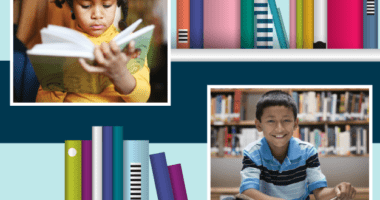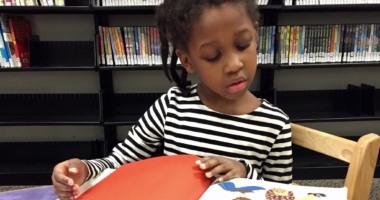Teachers Need to Learn How to Teach Reading Effectively
Every teacher has that handful of indelible memories of their teaching experiences, when the impossible becomes possible in an instant. One of mine happened in the fall of 2005, when I was a second-year eighth-grade math teacher in New York City, and a student in my class had just used the phrase “partial quotients division.”
Antonio was a quiet young man who had barely spoken until then. The class was working in small groups on an algebraic task involving the division of multidigit numbers. When Antonio saw that his group was struggling with the long division, he suggested they try partial quotients division, a method he had learned from a math tutor the previous summer. Having not heard of this method myself, I leaned in as closely as my students to watch Antonio break down a problem to the “oohs” and “ahs” of the class. Suddenly, I realized that my teaching practices were too narrow, and I wasn’t reaching all my students. Instead, I needed to provide a range of strategies to help my students’ build their conceptual understanding of math. Antonio helped me see a better way to teach the division of multidigit numbers — and a way to create more breakthrough moments for my students.
For teachers, those kinds of revelations about how to better meet their students’ needs shouldn’t be left to chance. And the sooner they can happen in a teacher’s career path, the better.
Right now, in schools across the country, huge numbers of teachers are experiencing the same kind of epiphany in reading instruction that I had in math. They’re learning that the early literacy practices they were taught in their teacher preparation programs and district-provided professional development run counter to decades of research.
It’s unlikely that a bunch of Antonios will trigger ah-ha! moments about reading instruction by leaning over to their peers and saying, “I see you struggling to read that word by guessing based on the pictures. Let’s try some explicit phonics instruction.” No. It’s up to leaders in states, districts, and teacher preparation programs to make sure that every teacher is prepared to teach reading based on scientifically sound principles.
More than 50 years of research provides a clear picture of effective literacy instruction. These strategies and methods — collectively called scientifically based reading instruction, which is grounded in the science of reading — could dramatically reduce the rate of reading failure. Nearly 1 million additional children could successfully become proficient readers by fourth grade each year if all teachers implemented scientifically based reading instruction – explicit and systematic instruction in foundational literacy skills and daily opportunities to think, speak, read, and write about authentic texts.
In June 2023, the National Council on Teacher Quality (NCTQ) released a report titled “Teacher Prep Review: Strengthening Elementary Reading Instruction,” which analyzed nearly 700 teacher preparation programs and how they teach aspiring teachers to teach reading. The main finding was that few programs (28%) adequately address scientifically based reading instruction. This finding may explain why a recent survey conducted by Education Week found that most elementary special education and K-2 teachers (72%) say they use literacy instructional methods that incorporate practices debunked by cognitive scientists decades ago.
Notwithstanding, there is some cause for optimism. States like Colorado and Mississippi have made early literacy a priority, setting smart policy and backing it up with major investments. Many districts have wisely used federal COVID-relief funds to adopt high-quality instructional materials and teacher professional development aligned to the science of reading. The 60 teacher preparation programs that earned an A+ in NCTQ’s analysis show that it is possible, in both undergraduate and graduate preparation models, to provide teacher-candidates with the strong pedagogical foundation they need to effectively teach reading.
NCTQ also analyzed the extent to which programs prepare candidates to teach reading to students with diverse needs. We looked specifically at three groups: 1) English learners; 2) struggling readers, including students with dyslexia; and 3) students who speak varieties of English other than mainstream. Our findings suggest that teacher preparation has a long way to go to provide new teachers with the skills they need to best support these young learners.
More than 5 million English learners step into our nation’s public schools each year. Yet 69% of teacher preparation programs spend fewer than two hours of course time preparing teacher-candidates to leverage the assets these students bring to the classroom that will help them learn to read English. And since the majority of the U.S. student body comprises students of color, it’s increasingly likely that new teachers will enter classrooms to be teaching English learners — but without the knowledge or skills they need to use scientifically based reading instruction to bolster English language development and reading — nor have the instructional materials that are both rigorous and representative of their students’ cultures and experiences.
The story is similar for struggling readers. The International Dyslexia Association estimates around 20% of the population may have symptoms of dyslexia. Again, NCTQ found a disconnect between student demographics and teacher preparation programs’ allocation of precious instructional hours for teacher candidates. Of the programs we analyzed, 57% spend fewer than two hours of course time teaching candidates how to support struggling readers.
If classroom teachers do not receive the specialized knowledge and skills needed to effectively teach reading to English learners and struggling readers, both groups of students are at risk of falling behind in every other aspect of their education that depends on strong reading skills — and ultimately will miss out on opportunities later in life.
NCTQ, of which I am the chief of teacher preparation, also found that just 10% of the programs we analyzed included instruction related to teaching reading to students who speak varieties of English other than mainstream. Often, these rule-governed languages spoken by communities are connected by race, culture, and identity — such as African American English (AAE), Cajun English, and Appalachian English, among others. This emerging area in teacher preparation merits more attention from programs and textbook authors. Organizations like the Variations in Oral and Written English Language (VOWEL) Lab at the University of California-Irvine are leading the way in helping the field identify instructional approaches that help students bridge connections between home and school language using techniques like codeswitching.
In January, NCTQ released a new report, “State of the States 2024: Five Policy Actions to Strengthen Implementation of the Science of Reading” and an action guide as companion reports to the teacher prep report from last June, along with state-specific profiles. These state-focused reports are the result of our analysis of policies on reading from all 50 states and Washington D.C. We report on each state, describe national patterns, offer recommendations, and hold up promising examples of state initiatives likely to move the needle for students with a range of diverse needs.
Waiting to introduce the science of reading until after a teacher is in the classroom does the profession a disservice and leaves too many students at risk. Ultimately, all students will have a better opportunity to become strong readers if teacher preparation programs and state policy makers ensure that teachers are taught scientifically based reading instruction and have practice opportunities before they are a teacher of record. Let teacher-candidates’ ah-ha moments happen within the safety of their preparation programs — when the stakes are lowest for students.
There is a literacy crisis in the U.S. and teacher prep programs can be part of the solution. Learning to teach reading effectively takes lots of work, planning, and preparation from state leaders, policymakers, and teacher prep programs. But taking those necessary steps will lead to a country whose students can learn to read well.
Rob Noble is the Chief of Teacher Preparation at NCTQ





